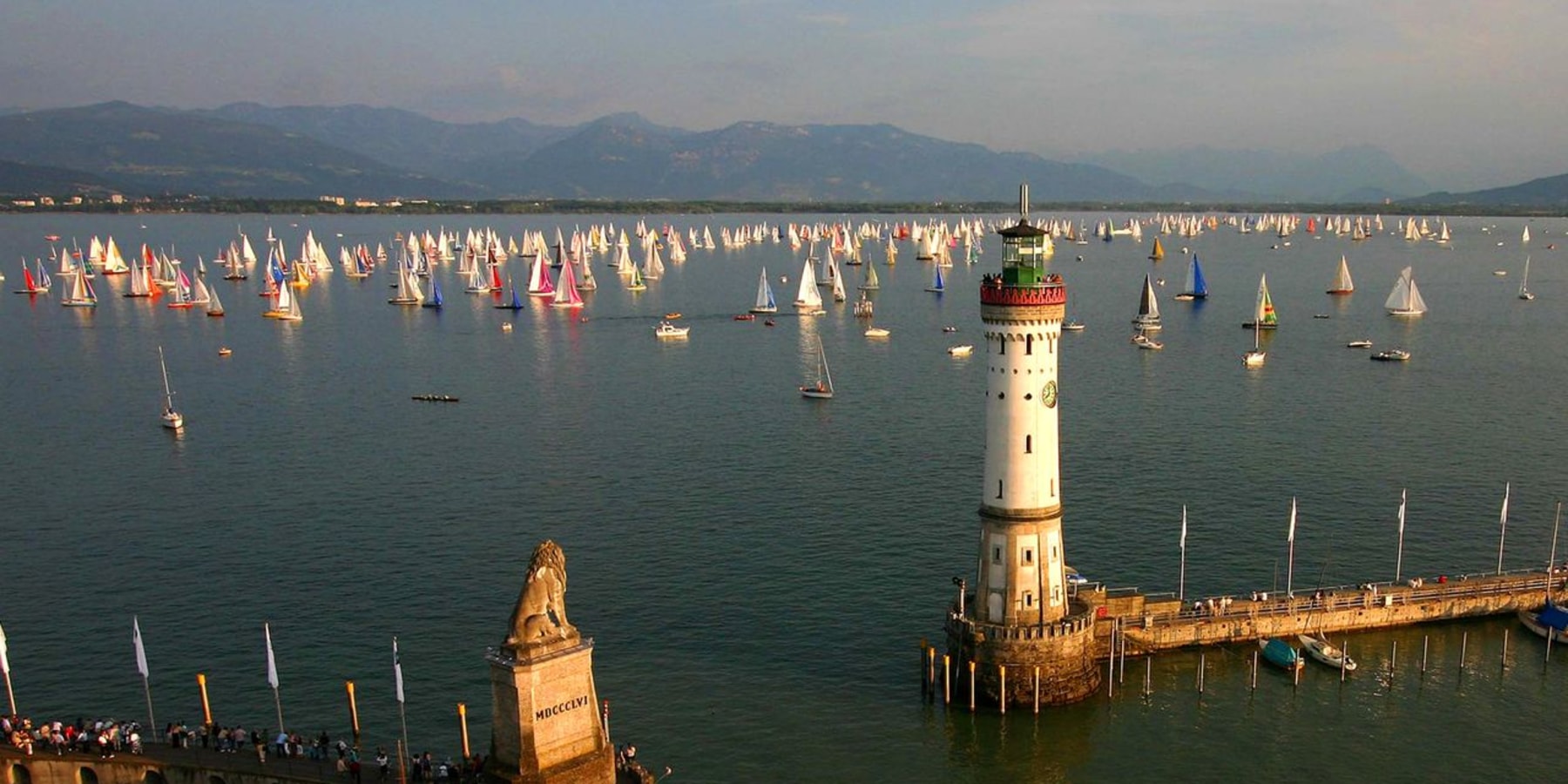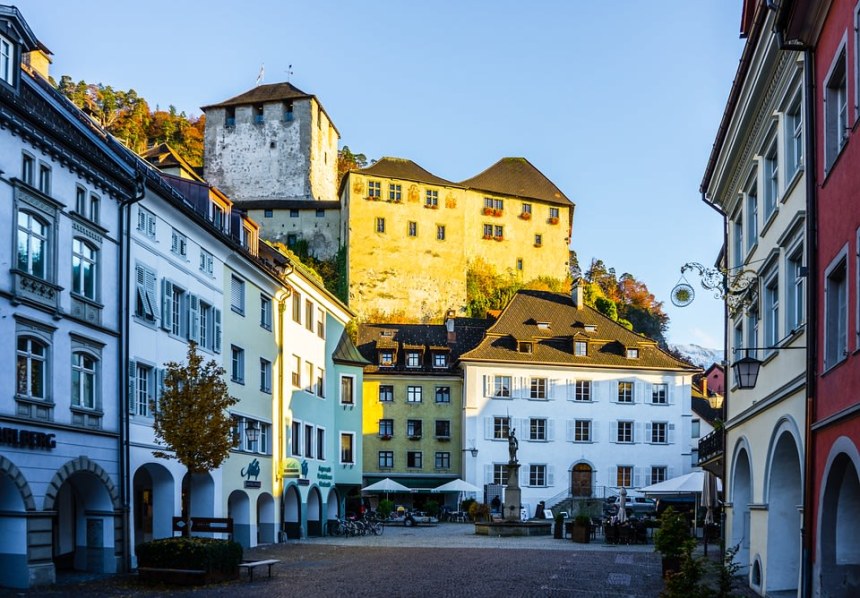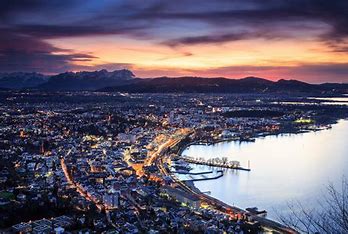
Austria’s westernmost province of Vorarlberg lies on a narrow piece of land near Germany, Switzerland, and Liechtenstein. Famous for its high peaks, large and deep valleys, and blue lakes, the biggest one Lake of Constance. There aren also extensive rural areas with lush pastures that help produce its famous cheeses. There are high Alpine regions in Vorarlberg, which are a magnet for mountaineers and winter sports enthusiasts. But that`s absolutely not the only interesting point I`d like to point out the beautiful medieval cities with their castles, as well as a cultural offer of international standard as the Festival of Bregenz or the Schubertiade.
Vorarlberg is one of Europe’s best-kept secrets and is probably Austria’s most distinctive province. Due to its remote location, the province has always led a life slightly separate from the rest of Austria.
For many centuries, culturally and economically, Vorarlberg has oriented itself towards Switzerland and southern Germany. Indeed, at one point after World War I, Vorarlberg very nearly merged with Switzerland.
Although innovative and forward-looking, this mountainous province has fostered a keenness to maintain cultural continuity and links with its past, being proud of the region’s cuisine, architecture, design, and woodworking traditions.
Whether your interests lie in skiing down lofty mountain peaks, hiking, exploring charming villages, museum-hopping, munching on delectable food, or just chilling by the water, there’s something for everyone to do and see in Vorarlberg.
Should you be visiting Vorarlberg in the summer or the warmer months, getting around on a bicycle is a fun way to see the province. All kinds of bicycles are available for rent at several sports outlets and hotels all over Vorarlberg.
There are several notable attractions. In a nutshell, the following are my favourite things to see and do in Vorarlberg and the south of Lake Constance.
The Bregenzerwald (mountainous region with forests near Bregenz)
Although it is popular with Austrians, Swiss, and Germans, the bucolic delights of the remarkably scenic Bregenzerwald remain largely unknown to outsiders.
The region is made up of a patchwork of dairy-farming villages among an undulating landscape. However, there isn’t a dense proliferation of trees as its name suggests.
The Bregenzerwald is also known for its pretty architecture, and you’ll come across many traditional wooden farmhouses that are made using wood from local pine and spruce trees.
Often adorned with carved eaves and balconies overflowing with colourful flowers, these rustic shingle-clad houses are still an incredible sight set within the green valleys and mountainous backdrop.
Wood has always played an intrinsic role in Vorarlberg’s culture as is evidenced by the many wooden buildings throughout the region. Given the abundance of wood in the Bregenzerwald, the locals here have acquired exceptional skills in dealing with the material. Just like other regions of Austria, Bregenzerwald also has a traditional women’s costume (tracht). The so-called “Juppe” is a decorative, overtly feminine dress, that is the oldest traditional costume in the Alpine region dating to the 15th century. The festive costume is worn by women in the Bregenzerwald on festive occasions on Sundays
Another place worth exploring in Schwarzenberg is the local Holy Trinity Church (Dreifaltigkeitskirche). Here, you can see Angelika Kauffmann’s paintings depicting Christ’s apostles and disciples in the nave.
Schwarzenberg also hosts the annual Schubertiade, the world’s leading festival celebrating the work of Austrian musician Franz Schubert. Taking place in mid-June and late August, Schubertiade features Schubert-penned songs performed by top international names.
Bregenz
Vorarlberg’s capital, Bregenz, is situated on the southeastern shores of Lake Constance at the edge of the Rhine valley and at the foot of the Austrian and Swiss Alps.
With a population of around 30,000, it combines the laid-back gentility of a lakeside resort with the vigour of a bustling business and cultural centre.
Bregenz boasts a broader range of sights as the KUNSTHAUS, with installations and exhibitions of internationally renowned contemporary artists, the Martin`s Tower, the medieval upper town, the Regional Museum and, first of all, the Festival`s site on Lake Bregenz, Lake Constance (Bodensee)
The focal point of attention in Bregenz is Lake Constance (Bodensee) itself. One of the best-known European lakes, it is the third-largest freshwater lake in the European Union and certainly one of its most scenic.
The promenade along the Bodensee’s shoreline is understandably a popular hangout, especially in the summer.
The internationally acclaimed annual Bregenz Music Festival (Bregenzer Festspiele) takes place at the western end of the park. Held annually during a four-week period from mid-July to mid-August, the festival features theatre and opera performances, as well as symphony concerts and fine art exhibitions.
Bregenz is featured in the film Quantum Of Solace (2008), in the scene where James Bond (Daniel Craig) identifies members of Quantum watching the performance of Tosca on the shores of Lake Constance.
The Bregenz Upper Town (Oberstadt/Altstadt)
The formerly fortified Upper Town (Oberstad/Altstadt) is the oldest part of Bregenz and features several well-preserved historic buildings and the remains of a 13th-century fortification.
Notable attractions in the Upper Town include the inescapable St. Martin Tower (Martinsturm, the Old Town Hall (Altes Rathaus), and the Parish Church of St. Gallus (Pfarrkirche St Gallus)—a 14th-century Gothic structure with splendid Baroque interiors.
The rectangular St. Martin’s Tower is probably the most recognizable landmark in Bregenz and has become a symbol of the city. Finally, don’t miss the imposing half-timbered Old Town Hall in the center of the Upper Town! It looks like something straight out of a fairy tale.
Bregenz Lower Town (Innenstadt)
Bregenz’s Lower Town (Innenstadt/Unterstadt) is a much newer and more modern part of town. It is home to the city’s premier shopping district, where you’ll find plenty of boutiques and trendy wine bars below elegant domes, gables, and towers.
Der Pfänder
Commanding an excellent panorama of Lake Constance to the northeast of town is the 1,064-meter-high peak Pfänder. It is a favourite destination for hikers and is roughly a two-hour trek via a steep footpath.
Lindau
This beautiful medieval town is just across the borders of Bregenz in Austria and nearby Switzerland.
Lindau is one of southern Germany's most picturesque towns with an interesting old town located on an island off the shores of Lake Constance.
A favourite walk for almost every visitor is out to the Lindau lighthouse and the Bavarian lion sculpture at the harbour entrance, with great views back over the water to Lindau's old town.
There is plenty to see and do in the town itself, but it also makes a good base for exploring other towns along the lake shore, both in Germany and
The summer ferry services make it easy to visit other Lake Constance towns, such as Friedrichshafen, Meersburg and Konstanz while admiring the backdrop of the Alps.
The town of Lindau is the start of the German Alpine Road tourist route through Berchtesgaden
Feldkirch
Feldkirch is the second-largest town in Vorarlberg and is also the most westerly town in Austria. This charming medieval market town certainly deserves a stopover. The best thing to do in Feldkirch is take a leisurely stroll through the Old Town, which is completely pedestrianized.
You can admire the numerous late-Gothic townhouses, many of which are graced with large bay windows and frescoed facades.
One of the highlights of the Old Town is the Gothic Feldkirch Cathedral (Domkirche St. Nikolaus). It`s really worth admiring its double nave, exquisite kaleidoscopic stained-glass windows, and Wolf Huber’s famous Annenaltar (1521), which features the Lamentation of Christ.
Other notable sights in the Old Town include the ornate 14th-century Chur Gate (Churer Tor) and the spindle-shaped Cats Tower (Katzenturm), which gets its name from the lions’ heads that once adorned the defence cannon housed here.
The Schattenburg Castle
The Schattenburg Castle, which sits majestically above Feldkirch dates back to the 12th century, Schattenburg is one of Austria’s best-preserved medieval castles.
Today, Schattenburg Castle houses a museum devoted to history with a collection of medieval weaponry, peasant crafts, furnishings, religious art, and costumes from the period. You don’t have to be a medieval nerd to enjoy a tour of the castle and museum.
From the castle, you can also enjoy panoramic views of Feldkirch and the Rhine Valley.
Dornbirn
Located in the heart of Vorarlberg, Dornbirn is the province’s commercial hub and largest town. Famed for its many textile companies, the town acquired the moniker “city of textiles.”
Dornbirn’s main market square is graced by a 19th-century neoclassical parish church and by an attractive 17th-century building – the Red House (Rotes Haus). The town has little tourist appeal except for a few notable attractions in its environs.
The Roll`s Royce Museum
Although virtually all the cars are stunningly gorgeous, the highlight of the collection is the various Phantom-model Rolls-Royces.
You can see the white 1927 Phantom I that Peter O’Toole drove in Lawrence of Arabia; the 1932 Phantom II driven by actress Rita Hayworth; and the elegant 1936 Phantom III, which belonged to the late Queen Mother of the British Royal Family.
Vorarlberg Cuisine
One of the best things to do in Vorarlberg is sampling the province’s hearty cuisine. The cuisine of Vorarlberg is a little distinct from other regions in Austria and is more closely aligned with the eastern cantons of Switzerland and Upper Swabia in Germany. Cheese, of course, features prominently in many dishes.
One of the most popular foods from Vorarlberg is Kässpätzle (Käsknöpfle). The rustic dish, which is a combination of egg pasta with cheese and roasted onion, is very much a local staple. Jacky and I are both huge fans of Kässpätzle and have consumed copious amounts of this delicious dish.
Finally, a visit to Vorarlberg wouldn’t be complete without sampling the region’s famed and delicious cheeses. Cheese is a way of life in Vorarlberg and is enjoyed throughout the day as a delicacy in its own right.
If you’re a cheese lover, You’ll get your money’s worth. There are more than 60 cheese varieties to choose from, and each has its own individual flavour, texture, and aroma.
Popular beers that you’ll encounter throughout Vorarlberg are Fohrenburger, Mohren, and Egger Breer
The beauty of Lech and Zürs
The dramatic Arlberg massif is home to mountainscapes of desolate beauty. Here, you will find the beautiful mountain village resorts of Lech am Arlberg and Zürs am Arlberg.
Situated on a large plateau at an elevation of 1,440 meters above sea level, Lech is the archetype of a snug alpine ski village. It offers a large number of ski options that challenge intermediate skiers as well as professionals.
In summer, thanks to the lush mountain meadows, deserted mountain lakes, emerald green peaks, and an incredible array of walking trails, the area is a paradise for demanding hikers, bikers, climbers, and those seeking adventure.
Lech has still managed to preserve some of its rural charms thanks to some attractive alpine wooden log houses and a dainty Gothic Parish Church (Pfarrkirche). Overlooking the village center from a small hillock, the church boasts some faded 14th-century frescoes.
The Montafon Valley and Bludenz
Although known for its winter sports, the Montafon Valley is also popular in summer. The warm-weather allure here revolves around walking, hiking, and climbing in the alpine majesty of Vorarlberg.
Montafon Valley locals pride themselves on the proximity of Piz Buin, the highest peak in Vorarlberg at 3,312 meters above sea level.
Two of the best-known villages in the Montafon Valley are Schruns and Tschagguns. Schruns is the largest resort, lying on the right bank of the Ill River, while the smaller Tschagguns lies to the southwest of Schruns.
Take a relaxed stroll through the historical centre of Schruns and admire the charming local houses.
The influential American literary icon Ernest Hemingway hiked to this region in 1925. The town of Bludenz is beautifully situated at the confluence of five alpine valleys. Aside from being a regional transport hub, it is a popular resort with excellent skiing areas in its vicinity.
The small town is worth a quick stroll through its center. It has some historic sights, including rows of 17th-century townhouses. It is worth checking out the Upper Gate (Oberes Tor), a former city gate that now houses the town history museum.
The big draw in Bludenz is the 16th-century Parish Church St. Lawrence (Laurentiuskirche), which is noted for its impressive 48-meter octagonal tower. Inside are two original altars made from black marble and paintings showing the Marriage of the Virgin Mary and the Visitation.
The Rankweil Basilica
Majestically surveying the town of Rankweil from a crag, the imposing Rankweil Basilica (Basilika Rankweil) looks straight out of a fairy tale. The church itself dates from the 8th century but gained its current late-Gothic appearance from an extensive face-lift in the late 15th century.
The main object of veneration for pilgrims to Rankweil is the 13th-century silver-plated cross that bears a tender relief of the crucified Christ.
Various miracles have been attributed to the cross that has turned Rankweil into the main pilgrimage center for the Roman Catholic population in this region of Europe.
The wooden parapet outside the church offers excellent panoramas of the Rhine Valley and the Swiss Alps.
the Silvretta Hochalpenstraße
The Silvretta Hochalpenstraße deserves to be on any list of the world’s most scenic drives. Stretching a little over 22 km in length, the spectacular private toll road runs just beyond the village of Partenen to the Silvretta Reservoir and Bielerhöhe Pass at the southeastern end of the Montafon Valley over 34 hairpin bends.
It’s one of the most popular tourist attractions in Vorarlberg. The road is open from around May to October, though it will stay open or open early if conditions permit.
Whether you are looking for a hotel in the city centre, at a leading winter resort, on the edge of a lake, or in unspoiled countryside, Vorarlberg offers accommodation that favours all tastes and budgets. The small size of Vorarlberg makes it possible for you to set up camp in one place and conveniently travel from there to Switzerland, Liechtenstein and Germany.
Poetic Nature
The most biodiverse nature reserve in Vorarlberg is to be found near the Rhine Delta on the Lake of Constance. The Rhine delta, with its peninsulas, bays and marshlands, is not only a refuge for birds and plants – it is also a uniquely beautiful and exciting wilderness.
The Old Rhine flows in its wildly romantic manner through the middle, reflecting all shades of green now in the warm backlight.
First of all, let’s take a look at the geography. Coming from Switzerland, the Rhine actually flows through Lake Constance. It enters in the southeast and comes back out in the west, bringing with it around three million cubic metres of suspended matter per year. The Rhine delta in the southeast of Lake Constance extends from the Old Rhine on the Swiss border via the Rhine avulsion close to Fußach, the so-called New Rhine. The European nature reserve, the second-largest in Vorarlberg and the most biodiverse is home to four villages.
“In addition to Fußach and Hard, we have Höchst and Gaißau as well as the state of Vorarlberg as members,” Walter Niederer, Manager of the Naturschutzverein Rheindelta, tells us. The association sees itself as a mediator between the interests of the villages on the one hand and issues pertaining to the nature reserve on the other hand. “The Rhine delta is extremely attractive for cyclists, for walkers and, of course, for bathers,” says Niederer. “However, several areas have to be especially protected at certain times of the year.” This is to help Mother Nature keep her massive shallow water zones as uniquely biodiverse as they are.
The Rhine delta is extremely attractive for cyclists, for walkers and, of course, for bathers.
The Rhine delta is home to 330 species of bird, 160 species of wild bees and around 600 plants.
And suddenly you discover in the meadow not only white storks but maybe also a lapwing. You stroll not only through the green countryside but through the reeds past willow trees.
You can see every shade of blue in Lake Constance – as well as any amount of birds.



